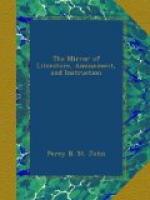16. It is useful to know, that the shadows of morning are darker than those of evening; also, that when objects are in shadow, their light (as it is then a reflected light,) falls on the opposite side to that on which it would come if they were enlightened.
17. The harmony of the whole should be studied; if the piece strikes you as defective in this respect, place it at evening in some situation where it will not be reached by a strong light, when the misplaced lights and shadows will strike you more forcibly than in the glare of day.
18. To stain your paper with a slight reddish or yellowish tint, adds to the harmony of a sketch, yet it is a mere matter of taste; but, when it is desired, it had better be done after the drawing is completed, otherwise the colour risks looking patched from the rubber.[6]
[Footnote 6: Coffee has been recommended for this purpose, but delicate and pleasing washes or glazings may be produced from burnt sienna, yellow ochre, burnt umbre, and lake, in various combinations, and laid on extremely attenuated by water.]
19. In colouring, the sky gives the ruling tint to the landscape; it is absurd to unite a noonday sky, with a landscape of sunset glow.
20. From the three virgin colours, red, blue, and yellow, all the tints of nature are composed.[7] There is not in nature a perfect white, except snow, and the petals of some flowers.
[Footnote 7: The artist, however, cannot produce his tints from those simple colours entirely, but the advice once given to the writer, by a painter, was:—“Never fancy that many colours will effect your object; a few well chosen will better succeed, and be more easily managed; half-a-dozen would, for me, answer every purpose.” The student is warned against gaudy colouring, which, if allowable in caricatures seen elsewhere, reminds one of pedlar’s pictures.]
21. Sketch nothing but what you can adorn, (for the purpose of showing to friends, &c.) but do not adorn your first, or rough sketch; make another, and refer to your original draught, as you would do to the view itself, for it contains your general ideas—your first and freshest, which may be lost by endeavouring to refine and improve upon them in the original sketch.[8]
[Footnote 8: The old masters are well known to have made carefully many sketches of the subjects they designed for pictures, ere they dreamt of painting compositions that were to last for ever.]
22. In adorning your sketch, figures, both animate and inanimate, may be introduced, but sparingly; touch them slightly, for an attempt at finish offends.
I shall take the liberty of adding—endeavour to get a free and flowing outline; be not too minute either in detail or finishing; use pen or brush for your rough sketch in preference to pencil; you will gain confidence, and correctness will be your aim in your adorned copy. Finally, study nature, art, and good writers.




